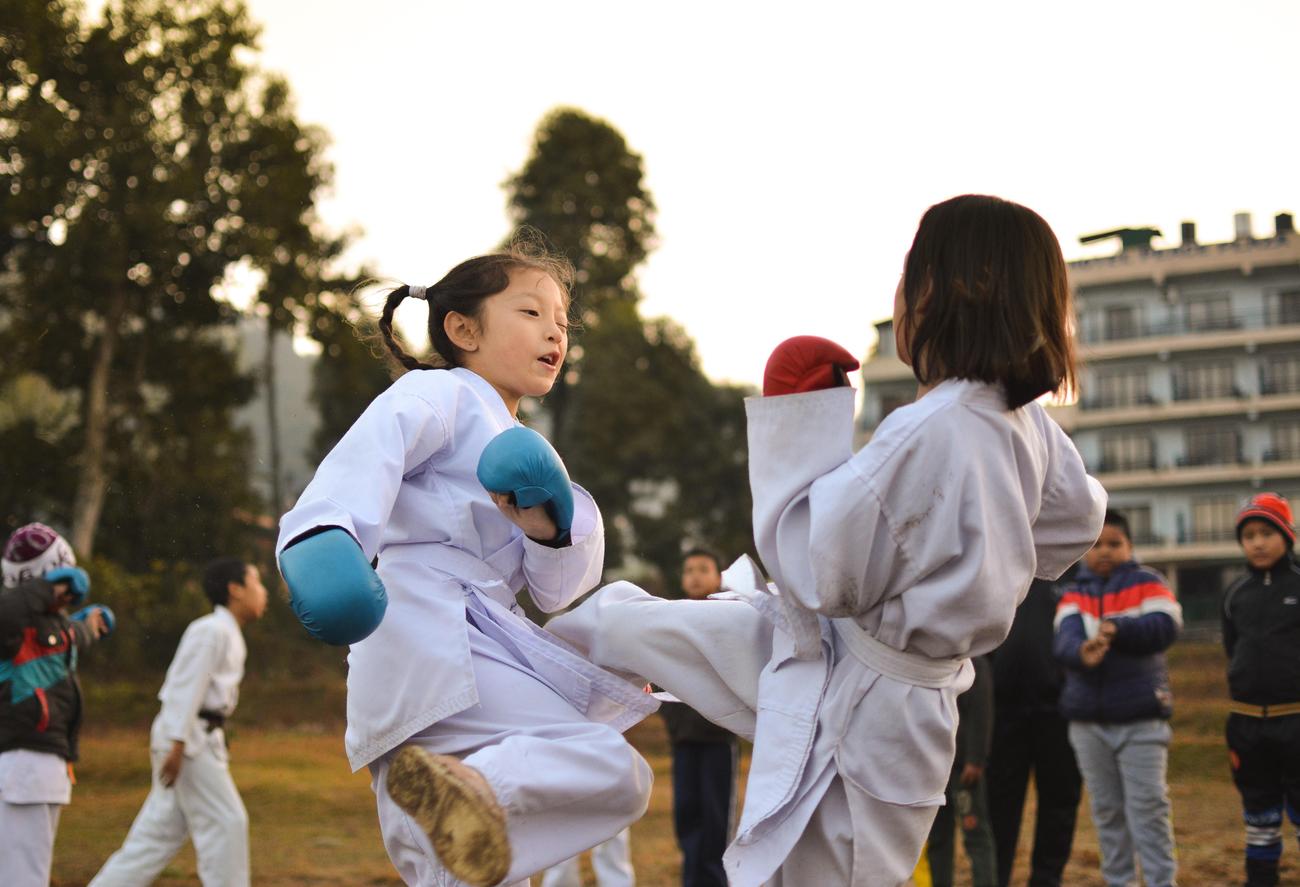Taekwondo is an Olympic sport. Taekwondo tournaments are held worldwide. These facts may be well-known, but what lies beneath the surface of this martial art is truly captivating. In this article, we delve into the truth about taekwondo, unveiling fascinating facts that go beyond its recognition in the sporting world. As an experienced martial arts enthusiast and sports journalist, I bring you an in-depth look at the history, techniques, and cultural significance of taekwondo. Prepare to be amazed as we uncover the physical and mental benefits associated with this ancient art. Get ready to discover the hidden world of taekwondo, where tradition meets modernity, and where legends are born.

Facts About Taekwondo
As a devoted martial arts enthusiast, I’ve spent years immersing myself in the world of taekwondo. Today, I want to share with you some fascinating facts about this ancient martial art that have captured the hearts and minds of millions worldwide. From its belt ranking system to its inclusion in the Olympic Games, taekwondo is truly a martial art like no other.
Belt Rankings and Skill Levels
One of the most recognizable aspects of taekwondo is its belt ranking system, which serves as an indication of a practitioner’s skill level. Starting from the beginner’s white belt, students progress through a series of colored belts before reaching the coveted black belt. Each belt represents a milestone in the trainee’s journey, signifying their growing expertise and dedication to the art. So if you ever wondered why taekwondo practitioners wear different colored belts, now you know!
“The belt ranking system in taekwondo not only symbolizes a practitioner’s skill level but also serves as a constant reminder to never stop striving for improvement.”
Olympic Recognition
In the year 2000, taekwondo achieved a momentous milestone by becoming an official Olympic sport. It joined judo as the only two martial arts included in the Olympic Games, solidifying its place on the global stage. Since then, taekwondo athletes from around the world have competed for gold, showcasing their incredible agility, precision, and strength. The inclusion of taekwondo in the Olympics has not only elevated its popularity but has also provided a platform for athletes to demonstrate their mastery of this dynamic martial art.
“Taekwondo’s inclusion in the Olympic Games has propelled the sport to new heights, inspiring both practitioners and spectators alike.”
A Rich History
Taekwondo boasts a rich history that dates back to the aftermath of World War II. It emerged with the visionary efforts of the President of South Korea, who sought to unify different martial arts styles into a single discipline. Drawing inspiration from ancient Korean martial arts and incorporating techniques from Chinese martial arts, taekwondo was born. Today, it stands as a testament to the resilience and determination of its founding pioneers.
“Unveiling the fascinating history of taekwondo unveils a story of passion, unity, and the pursuit of physical and mental excellence.”
Worldwide Popularity
Taekwondo has spread its influence far and wide, captivating the hearts of millions across the globe. With its emphasis on discipline, self-control, and physical fitness, it comes as no surprise that taekwondo ranks as one of the most widely practiced martial arts in the world. From vast training halls to local dojos, individuals of all ages and backgrounds have embraced taekwondo as a means of personal growth, self-defense, and even competitive sport.
“The global popularity of taekwondo speaks volumes about its universal appeal and the multitude of benefits it offers to its practitioners.”
Physics Principles and Technique
What sets taekwondo apart from other martial arts is its integration of physics principles to generate power and speed in its techniques. By mastering the application of balance, momentum, and force, taekwondo practitioners can unleash devastating strikes and awe-inspiring kicks. The beauty of taekwondo lies not only in the physical prowess required but also in the scientific understanding behind its execution.
“Understanding the application of physics principles in taekwondo unlocks a whole new level of appreciation for the art’s dynamic and explosive nature.”
When diving into the world of taekwondo, it’s essential to arm yourself with knowledge about its history, cultural significance, and techniques. Thankfully, there are countless online sources like thewayfamilydojo.com, rockytopsportsworld.com, sportsver.com, martialminded.com, and business2community.com that can provide you with comprehensive insights into the fascinating realm of taekwondo.
Let the beguiling power of taekwondo inspire you to embark on your own martial arts journey, as it has for millions around the world. So, are you ready to explore the secrets and wonders that lie within the realm of taekwondo?
“Indulging in the captivating world of taekwondo opens a gateway to self-discovery, physical well-being, and an unwavering sense of empowerment.”
Facts About Taekwondo:
Did you know that Taekwondo has more to offer than just a martial arts discipline? Get ready to be amazed by these 10 fun facts about Taekwondo! From its unique techniques to its rich history, Taekwondo has captivated people all around the world. Discover what makes Taekwondo truly unique and why it has become one of the most popular martial arts today. Interested in the history of Taekwondo? Dive into the fascinating history facts about Taekwondo and learn about its origins and evolution. Curious about when Taekwondo was invented? Uncover the answer and gain a better understanding of the timeline of this incredible martial art. If you love sports statistics, you won’t want to miss out on the intriguing Taekwondo statistics that showcase the achievements and records of talented athletes. And last but not least, if you want to become a Taekwondo expert, make sure to familiarize yourself with the rules of Taekwondo. This comprehensive guide will ensure you have a solid grasp of the sport’s regulations and techniques. So, what are you waiting for? Click here to explore 10 fun facts about Taekwondo, uncover what makes it unique, delve into its intriguing history, learn when Taekwondo was invented, discover fascinating statistics, and become well-versed in the rules of this captivating martial art. Let the journey begin!
Taekwondo is an Olympic Sport.
Taekwondo holds a special place in the Olympic Games, as it has been recognized and included as an official medal sport since the 2000 Sydney Games. This impressive feat is a testament to the widespread popularity and remarkable skill displayed by taekwondo practitioners worldwide. Just imagine the dedication and talent required to achieve the honor of representing your country on the Olympic stage!
But how did taekwondo become an Olympic sport? Well, it all started back in 1988, when it made its Olympic debut as a demonstration sport in its home country, South Korea, during the Seoul Games. The exciting demonstrations captivated audiences and showcased the power, grace, and precision of taekwondo techniques. As a result, taekwondo gained enough recognition and support to gain full medal status at the 2000 Olympics. Since then, it has been a staple at every Summer Olympics, captivating audiences with its fast-paced sparring matches and mesmerizing poomsae performances.
Taekwondo’s inclusion as an Olympic sport is a testament to its global appeal and the immense skill of its practitioners. It has come a long way since its humble beginnings and has rightfully earned its place on the grandest stage of all.
But what exactly does taekwondo entail as an Olympic sport? Well, let’s break it down. Taekwondo consists of two main disciplines in the Olympics: poomsae and sparring. Poomsae, also known as forms, focuses on a series of choreographed movements and techniques that demonstrate a practitioner’s technique, power, and accuracy. On the other hand, sparring is the heart-pounding combat aspect of taekwondo in which opponents engage in dynamic, lightning-fast exchanges of kicks and punches within a designated area. To make things more exciting, sparring is further divided into individual and team categories, adding an element of strategic teamwork to the mix.
While taekwondo’s inclusion in the Olympics primarily centers around its sparring aspect, poomsae also plays a significant role. As the ballet of taekwondo, poomsae embodies the grace and precision of the martial art. Similar to a gymnastics routine, practitioners perform a series of predetermined movements that showcase their mastery of techniques, balance, and control. So, while the intense sparring matches may steal the spotlight, poomsae adds an artistic and technical component to the sport that should not be overlooked.
From the adrenaline-fueled excitement of sparring to the disciplined elegance of poomsae, taekwondo offers a captivating display of athleticism and skill that truly embodies the Olympic spirit.
Now, you might be wondering, why taekwondo out of all the martial arts? After all, there are numerous other styles out there. Well, taekwondo’s recognition as an Olympic sport is a result of its rich history and global reach. Originating in Korea over 2,000 years ago, taekwondo has evolved and adapted throughout the years, incorporating various influences and refining its techniques. In the 1940s, Korean General Choi Hong Hi further modernized taekwondo, establishing a standardized curriculum and introducing a belt ranking system to gauge a practitioner’s skill level. This systematic approach to training and advancement has contributed to taekwondo’s popularity and growth worldwide.
Taekwondo’s extensive history and continuous evolution have shaped it into the dynamic and respected martial art it is today. It stands as a symbol of Korean culture and has become a global phenomenon cherished by millions.
Speaking of skill levels, the belt ranking system in taekwondo is a significant aspect that sets it apart from other martial arts. Just like in other disciplines, taekwondo utilizes a color-coded belt system to signify progress and achievement. From the humble white belt denoting a beginner to the prestigious black belt representing advanced proficiency, each belt carries its own challenges and responsibilities. The journey from one belt to the next requires dedication, perseverance, and a commitment to self-improvement. So, every time you see a black belt practitioner, you can be assured that they have navigated a rigorous path of training and discipline to reach that level.
The belt ranking system in taekwondo serves as a tangible representation of an individual’s progress and accomplishment, highlighting the dedication and effort required to excel in this martial art.
In summary, the presence of taekwondo as an Olympic sport is a testament to its global appeal and the immense skill possessed by its practitioners. From its beginnings as an Olympic demonstration sport in 1988 to its establishment as an official medal sport in 2000, taekwondo has continued to captivate audiences with its thrilling sparring matches and breathtaking poomsae performances. With its rich history, global reach, and belt ranking system, taekwondo exemplifies the very essence of an Olympic sport, showcasing the dedication, discipline, and excellence that athletes strive for.
Taekwondo’s status as an Olympic sport solidifies its position as a martial art that brings people together, transcending boundaries and uniting nations through the shared pursuit of mastery and athletic prowess.
Taekwondo tournaments are held worldwide.
Taekwondo tournaments are not limited to a specific region or country – they take place all around the globe. These tournaments provide a platform for taekwondo athletes of different skill levels to showcase their abilities and compete against one another. Whether you are a beginner or an experienced practitioner, there are opportunities for everyone to participate and test their skills in the competitive arena.
In taekwondo tournaments, there are three main categories of competition: form, sparring, and breaking. The form competition focuses on the precise execution of a series of choreographed movements, demonstrating technique, power, and accuracy. Sparring involves dynamic exchanges of kicks and punches between opponents within a designated area, showcasing their speed, agility, and strategy. Breaking showcases the practitioner’s strength and precision as they break boards or other materials using powerful strikes.
One remarkable aspect of taekwondo is its global reach. With an estimated global practicing population of less than 100 million people, taekwondo has gained immense popularity and recognition worldwide. It became an official Olympic sport in 2000, featuring in the Sydney Olympic Games. This milestone has elevated taekwondo’s status and brought it to the attention of a global audience.
The pinnacle of taekwondo tournaments is the World Taekwondo Championship, held every two years and organized by World Taekwondo. This esteemed event brings together taekwondo practitioners from various countries, competing for the title of world champion. With a global membership of 212 national member associations from five continents, World Taekwondo ensures that taekwondo tournaments are inclusive and open to anyone who is a member of a World Taekwondo Member National Association.
These tournaments embrace diversity and welcome participants from different schools, affiliations, and martial arts styles. It is an opportunity for practitioners to come together, learn from each other’s techniques, and expand their knowledge and skills in a competitive setting. Whether you are a member of a traditional taekwondo school or practice a different style altogether, taekwondo tournaments provide a platform for everyone to come together and celebrate the art of taekwondo.
In these tournaments, the skill levels of practitioners are often indicated by belt rankings. The white belt represents a beginner, while the coveted black belt signifies a master or expert level. These rankings symbolize an individual’s dedication, perseverance, and commitment to self-improvement. Through years of training and hard work, practitioners progress through the ranks, with the black belt serving as a testament to their proficiency and expertise in taekwondo.
Moreover, taekwondo’s recognition and inclusion in the Olympics further solidify its reputation as a formidable martial art. Its presence in the world’s premier sporting event showcases taekwondo’s athleticism, skill, and ability to captivate audiences worldwide. As one of the few martial arts entered as a full medal Olympic sport, taekwondo has earned its place among the elite disciplines of the sporting world.
In conclusion, taekwondo tournaments are a global phenomenon, bringing athletes from various backgrounds and skill levels together to compete and showcase their talents. These tournaments provide a platform for practitioners to test their skills, learn from one another, and celebrate the beauty of taekwondo. From the World Taekwondo Championship to local competitions held around the world, taekwondo tournaments are a testament to the art’s widespread appeal, unity, and the dedication of its practitioners. As the taekwondo community continues to grow, so does the impact and reach of these thrilling tournaments.

FAQ
Question 1: How long has taekwondo been an Olympic sport?
Answer: Taekwondo became an Olympic sport in the year 2000, when it was included in the Sydney Olympic Games.
Question 2: What are the different categories in taekwondo tournaments?
Answer: Taekwondo tournaments have three main categories: form competition, sparring, and breaking.
Question 3: How many people globally practice taekwondo?
Answer: It is estimated that less than 100 million people practice taekwondo worldwide, making it one of the most widely practiced martial arts globally.
Question 4: How often are the World Taekwondo Championships held?
Answer: The World Taekwondo Championships take place every two years and are organized by World Taekwondo.
Question 5: Which country is the most successful in taekwondo?
Answer: South Korea is the most successful nation in taekwondo, both in the Olympic Games and World Championships.
“`json
“`
- How the Telephone Revolutionized Business: A Historical Perspective - April 19, 2025
- Understand bone yellow: Colorism’s impact on Black communities - April 19, 2025
- Green Natural Sandstone: Eco-Friendly Building Solutions - April 19, 2025
















